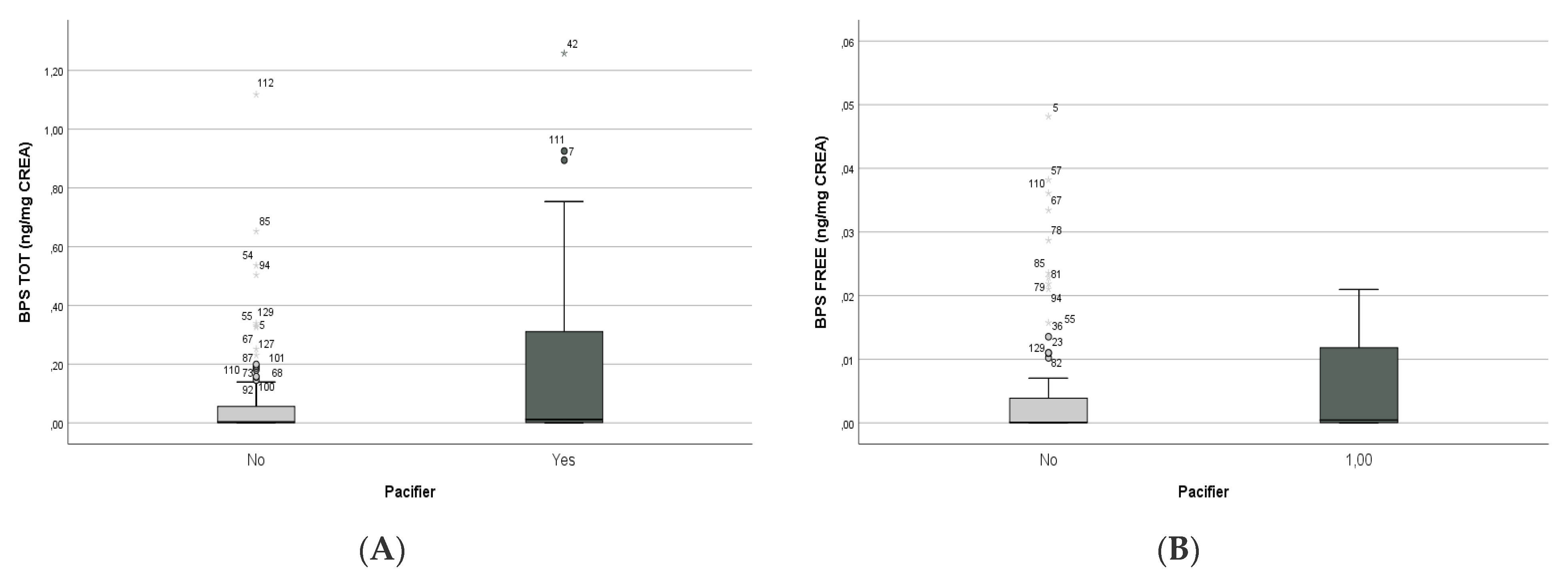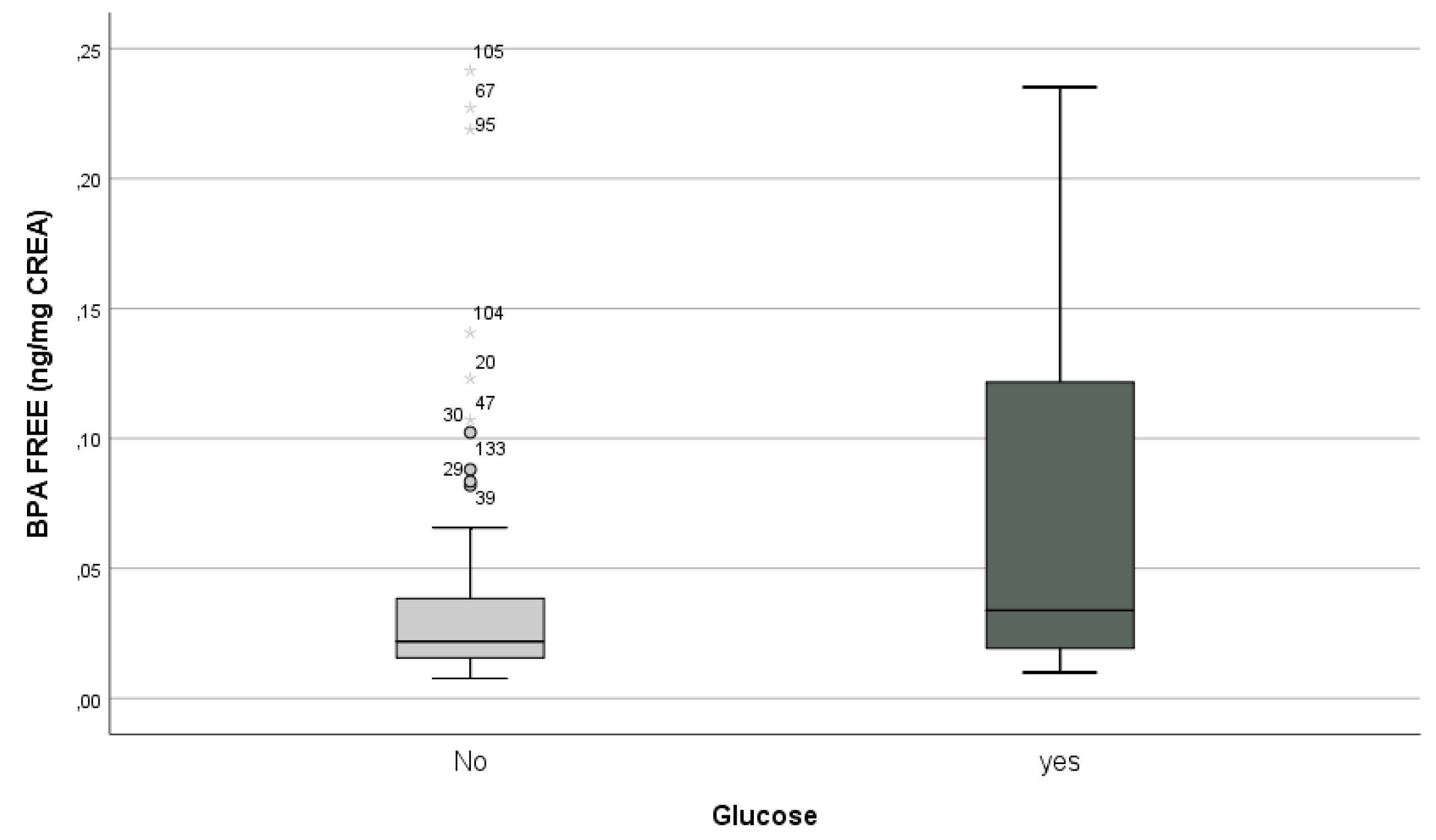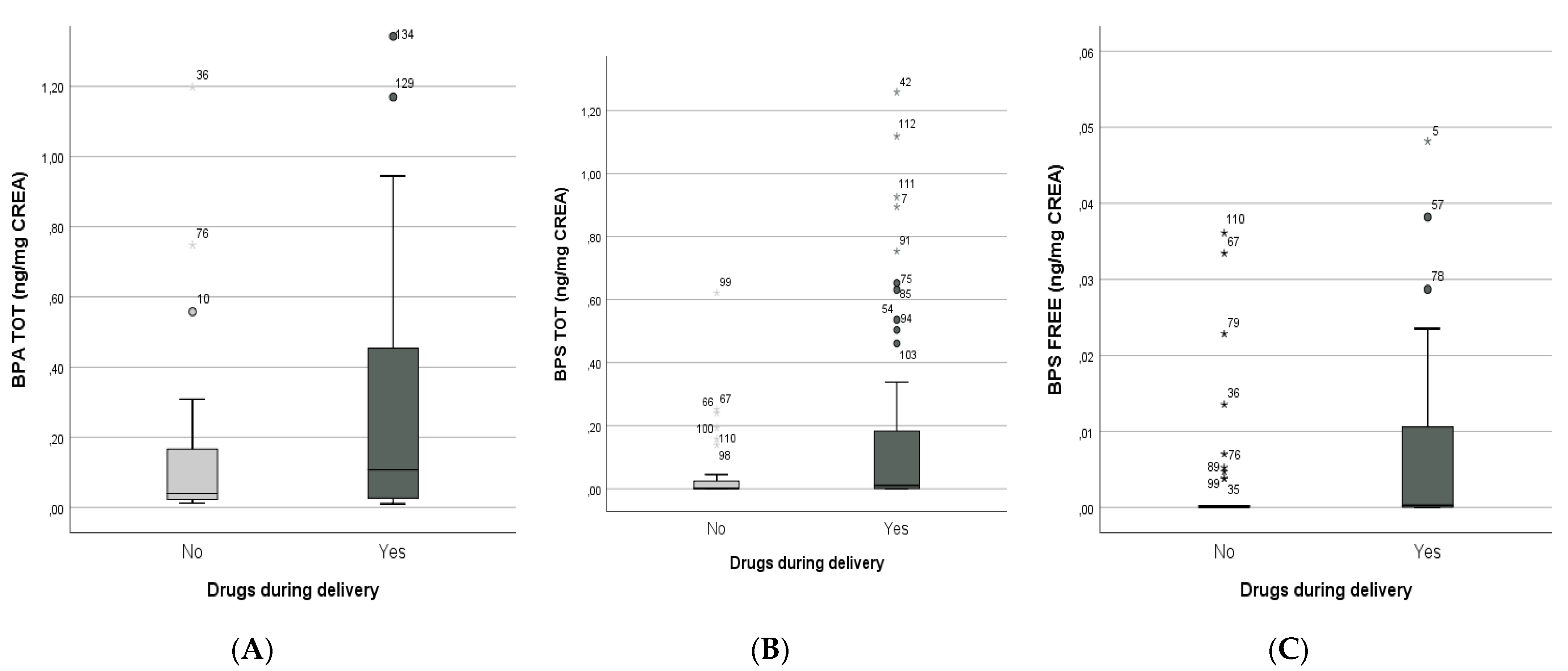Bisphenol A and S in the Urine of Newborns: Plastic for Non-Food Use Still without Rules
Abstract
Simple Summary
Abstract
1. Introduction
2. Material and Methods
2.1. Epidemiological Sample
2.2. Questionnaire
2.3. Biological Analysis
2.3.1. Urine Sample Collection
2.3.2. Free BPA and BPS
2.3.3. Total (Free + Conjugated) BPA and BPS
2.3.4. Conjugated BPA and BPS
2.3.5. Analysis
2.3.6. Creatinine
2.4. Statistical Analysis
3. Results
- Not-fully completed information (questionnaire and infant data);
- Insufficient urine samples (mothers: <30 mL/babies: <5 mL);
- Withdrawal of informed consent.
4. Conclusions
Author Contributions
Funding
Institutional Review Board Statement
Informed Consent Statement
Data Availability Statement
Acknowledgments
Conflicts of Interest
References
- Zalko, D.; Soto, A.M.; Dolo, L.; Dorio, C.; Rathahao, E.; Debrauwer, L.; Faure, R.; Cravedi, J.-P. Biotransformations of bisphenol A in a mammalian model: Answers and new questions raised by low-dose metabolic fate studies in pregnant CD1 mice. Environ. Health Perspect. 2003, 111, 309–319. [Google Scholar] [CrossRef]
- García-Córcoles, M.T.; Cipa, M.; Rodríguez-Gómez, R.; Rivas, A.; Olea-Serrano, F.; Vílchez, J.L.; Zafra-Gómez, A. Determination of bisphenols with estrogenic activity in plastic packaged baby food samples using solid-liquid extraction and clean-up with dispersive sorbents followed by gas chromatography tandem mass spectrometry analysis. Talanta 2018, 178, 441–448. [Google Scholar] [CrossRef]
- Bittner, G.D.; Denison, M.S.; Yang, C.Z.; Stoner, M.A.; He, G. Chemicals having estrogenic activity can be released from some bisphenol a-free, hard and clear, thermoplastic resins. Environ. Health 2014, 13, 103. [Google Scholar] [CrossRef]
- Duty, S.M.; Mendonca, K.; Hauser, R.; Calafat, A.M.; Ye, X.; Meeker, J.D.; Ackerman, R.; Cullinane, J.; Faller, J.; Ringer, S. Potential sources of bisphenol A in the neonatal intensive care unit. Pediatrics 2013, 131, 483–489. [Google Scholar] [CrossRef] [PubMed]
- Mercogliano, R.; Santonicola, S. Investigation on bisphenol A levels in human milk and dairy supply chain: A review. Food Chem. Toxicol. 2018, 114, 98–107. [Google Scholar] [CrossRef] [PubMed]
- Talsness, C.E.; Andrade, A.J.M.; Kuriyama, S.N.; Taylor, J.A.; vom Saal, F.S. Components of plastic: Experimental studies in animals and relevance for human health. Philos. Trans. R. Soc. Lond. B Biol. Sci. 2009, 364, 2079–2096. [Google Scholar] [CrossRef]
- Geens, T.; Roosens, L.; Neels, H.; Covaci, A. Assessment of human exposure to Bisphenol-A, Triclosan and Tetrabromobisphenol-A through indoor dust intake in Belgium. Chemosphere 2009, 76, 755–760. [Google Scholar] [CrossRef] [PubMed]
- Vandenberg, L.N.; Gerona, R.R.; Kannan, K.; Taylor, J.A.; van Breemen, R.B.; Dickenson, C.A.; Liao, C.; Yuan, Y.; Newbold, R.R.; Padmanabhan, V.; et al. A round robin approach to the analysis of bisphenol a (BPA) in human blood samples. Environ. Health 2014, 13, 25. [Google Scholar] [CrossRef] [PubMed]
- Wilson, N.K.; Chuang, J.C.; Morgan, M.K.; Lordo, R.A.; Sheldon, L.S. An observational study of the potential exposures of preschool children to pentachlorophenol, bisphenol-A, and nonylphenol at home and daycare. Environ. Res. 2007, 103, 9–20. [Google Scholar] [CrossRef] [PubMed]
- Pirard, C.; Sagot, C.; Deville, M.; Dubois, N.; Charlier, C. Urinary levels of bisphenol A, triclosan and 4-nonylphenol in a general Belgian population. Environ. Int. 2012, 48, 78–83. [Google Scholar] [CrossRef]
- Welshons, W.V.; Nagel, S.C.; vom Saal, F.S. Large effects from small exposures. III. Endocrine mechanisms mediating effects of bisphenol A at levels of human exposure. Endocrinology 2006, 147, S56–S69. [Google Scholar] [CrossRef]
- Golub, M.S.; Wu, K.L.; Kaufman, F.L.; Li, L.-H.; Moran-Messen, F.; Zeise, L.; Alexeeff, G.V.; Donald, J.M. Bisphenol A: Developmental toxicity from early prenatal exposurea. Birth Defects Res. Part B Dev. Reprod. Toxicol. 2010, 89, 441–466. [Google Scholar] [CrossRef]
- Nachman, R.M.; Fox, S.D.; Golden, W.C.; Sibinga, E.; Groopman, J.D.; Lees, P.S.J. Serial Free Bisphenol A and Bisphenol A Glucuronide Concentrations in Neonates. J. Pediatr. 2015, 167, 64–69. [Google Scholar] [CrossRef]
- Edginton, A.N.; Ritter, L. Predicting plasma concentrations of bisphenol A in children younger than 2 years of age after typical feeding schedules, using a physiologically based toxicokinetic model. Environ. Health Perspect. 2009, 117, 645–652. [Google Scholar] [CrossRef] [PubMed]
- Ackerman, L.K.; Noonan, G.O.; Heiserman, W.M.; Roach, J.A.; Limm, W.; Begley, T.H. Determination of Bisphenol A in U.S. Infant Formulas: Updated Methods and Concentrations. J. Agric. Food Chem. 2010, 58, 2307–2313. [Google Scholar] [CrossRef]
- Mielke, H.; Gundert-Remy, U. Bisphenol A levels in blood depend on age and exposure. Toxicol. Lett. 2009, 190, 32–40. [Google Scholar] [CrossRef]
- EFSA. Report on the two-phase public consultation on the draft EFSA scientific opinion on bisphenol A (BPA). EFSA Support. Publ. 2015, 12, 740E. [Google Scholar] [CrossRef]
- Moreman, J.; Lee, O.; Trznadel, M.; David, A.; Kudoh, T.; Tyler, C.R. Acute Toxicity, Teratogenic, and Estrogenic Effects of Bisphenol A and Its Alternative Replacements Bisphenol S, Bisphenol F, and Bisphenol AF in Zebrafish Embryo-Larvae. Environ. Sci. Technol. 2017, 51, 12796–12805. [Google Scholar] [CrossRef] [PubMed]
- Feng, Y.; Yin, J.; Jiao, Z.; Shi, J.; Li, M.; Shao, B. Bisphenol AF may cause testosterone reduction by directly affecting testis function in adult male rats. Toxicol. Lett. 2012, 211, 201–209. [Google Scholar] [CrossRef] [PubMed]
- Rochester, J.R.; Bolden, A.L. Bisphenol S and F: A Systematic Review and Comparison of the Hormonal Activity of Bisphenol A Substitutes. Environ. Health Perspect. 2015, 123, 643–650. [Google Scholar] [CrossRef]
- Skledar, D.G.; Schmidt, J.; Fic, A.; Klopčič, I.; Trontelj, J.; Dolenc, M.S.; Finel, M.; Mašič, L.P. Influence of metabolism on endocrine activities of bisphenol S. Chemosphere 2016, 157, 152–159. [Google Scholar] [CrossRef] [PubMed]
- CDC—PRAMS Questionnaires—Pregnancy Risk Assessment Monitoring System—Reproductive Health. Available online: https://www.cdc.gov/prams/questionnaire.htm (accessed on 20 March 2020).
- Rocha, B.A.; Da Costa, B.R.B.; De Albuquerque, N.C.P.; De Oliveira, A.R.M.; Souza, J.M.O.; Al-Tameemi, M.; Campiglia, A.D.; Barbosa, F. A fast method for bisphenol A and six analogues (S, F, Z, P, AF, AP) determination in urine samples based on dispersive liquid-liquid microextraction and liquid chromatography-tandem mass spectrometry. Talanta 2016, 154, 511–519. [Google Scholar] [CrossRef] [PubMed]
- Magnusson, B.; Örnemark, U. (Eds.) Eurachem Guide: The Fitness for Purpose of Analytical Methods–A Laboratory Guide to Method Validation and Related Topics, 2nd ed.; 2014; ISBN 978-91-87461-59-0. Available online: www.eurachem.org (accessed on 20 February 2020).
- Bono, R.; Bellisario, V.; Tassinari, R.; Squillacioti, G.; Manetta, T.; Bugiani, M.; Migliore, E.; Piccioni, P. Bisphenol a, tobacco smoke, and age as predictors of oxidative stress in children and adolescents. Int. J. Environ. Res. Public Health 2019, 16. [Google Scholar] [CrossRef] [PubMed]
- Gerona, R.; vom Saal, F.S.; Hunt, P.A. BPA: Have flawed analytical techniques compromised risk assessments? Lancet Diabetes Endocrinol. 2020, 8, 11–13. [Google Scholar] [CrossRef]
- Leng, H.; Zheng, X.; Yan, L.; Zhang, X.; He, H.; Xiang, M. Effects of different types and concentration of oral sweet solution on reducing neonatal pain during heel lance procedures. Chin. J. Pediatr. 2013, 51, 654–658. [Google Scholar]
- Bisphenol A: Part 1. Facts and Figures on Human and Environmental Health Issues and Regulatory Perspectives|RIVM. Available online: https://www.rivm.nl/publicaties/bisphenol-a-part-1-facts-and-figures-on-human-and-environmental-health-issues-and (accessed on 11 February 2020).
- Grignard, E.; Lapenna, S.; Bremer, S. Weak estrogenic transcriptional activities of Bisphenol A and Bisphenol S. Toxicol. In Vitro 2012, 26, 727–731. [Google Scholar] [CrossRef]
- Hashimoto, Y.; Moriguchi, Y.; Oshima, H.; Kawaguchi, M.; Miyazaki, K.; Nakamura, M. Measurement of estrogenic activity of chemicals for the development of new dental polymers. Toxicol. In Vitro 2001, 15, 421–425. [Google Scholar] [CrossRef]
- Ji, K.; Hong, S.; Kho, Y.; Choi, K. Effects of bisphenol s exposure on endocrine functions and reproduction of zebrafish. Environ. Sci. Technol. 2013, 47, 8793–8800. [Google Scholar] [CrossRef] [PubMed]
- Qiu, W.; Zhao, Y.; Yang, M.; Farajzadeh, M.; Pan, C.; Wayne, N.L. Actions of Bisphenol A and Bisphenol S on the Reproductive Neuroendocrine System during Early Development in Zebrafish. Endocrinology 2016, 157, 636–647. [Google Scholar] [CrossRef]
- Wan, Y.; Huo, W.; Xu, S.; Zheng, T.; Zhang, B.; Li, Y.; Zhou, A.; Zhang, Y.; Hu, J.; Zhu, Y.; et al. Relationship between maternal exposure to bisphenol S and pregnancy duration. Environ. Pollut. 2018, 238, 717–724. [Google Scholar] [CrossRef]




| Analyte | Molecularion (m/z) | Fragmention (m/z) | Declustering Potential (V) | Entrance Potential (V) | Collision Energy (V) | Collision Cell Exit Potential (V) |
|---|---|---|---|---|---|---|
| BPA | 227.0 | 212.0 | −79 | −9 | −23 | −14 |
| 227.0 | 133.0 | −79 | −9 | −30 | −14 | |
| BPA-d16 | 241.0 | 223.0 | −62 | −8 | −25 | −11 |
| 241.0 | 142.0 | −62 | −8 | −33 | −18 | |
| BPS | 249.0 | 108.0 | −75 | −3 | −35 | −13 |
| 249.0 | 92.0 | −75 | −3 | −38 | −13 | |
| BPS-d8 | 257.0 | 112.0 | −120 | −7 | −34 | −14 |
| 257.0 | 96.0 | −120 | −7 | −35 | −14 |
| PART A | NEWBORN GROUP (n = 134) | ||
|---|---|---|---|
| Sex | male | 84 (62.7%) | |
| female | 50 (37.3%) | ||
| Height at birth (cm) (Mean ± SD) | 52.9 ± 1.3 | ||
| Weight at birth (kg) (Mean ± SD) | 3.3 ± 0.4 | ||
| Cranial circumference (cm) (Mean ± SD) | 38.3 ± 1.6 | ||
| Breast-fed N (%) | 111 (82.8%) | ||
| Infant formula dispensed N (%) | 36 (26.9%) | ||
| Glucose dispensed N (%) | 38 (28.4%) | ||
| Pacifier dispensed N (%) | 42 (31.3%) | ||
| Respiratory procedures N (%) | 16 (11.9%) | ||
| General medical check-up N (%) | 85 (63.4%) | ||
| Diseases at birth N (%) | 32 (23.9%) | ||
| PART B | MOTHER GROUP (n = 134) | ||
| Age (Mean ± SD) | 33.9 ± 4.7 | ||
| Height (cm) (Mean ± SD) | 164.1 ± 7.1 | ||
| Weight (kg) (Mean ± SD) | Pre-pregnancy | 64.4 ± 13.9 | |
| End of pregnancy | 76.8 ± 13.7 | ||
| Δ | 12.3 ± 4.8 | ||
| BMI (Mean ± SD) | Pre-pregnancy | 23.9 ± 4.9 | |
| End of pregnancy | 28.5 ± 4.8 | ||
| Nationality N (%) | European | 126 (94%) | |
| Others | 8 (6%) | ||
| Education level N (%) | Low level | 20 (14.9%) | |
| Medium level | 51 (38%) | ||
| High level | 63 (47.1%) | ||
| Occupation N (%) | Yes | 114 (85.1%) | |
| No | 6 (4.5%) | ||
| Others | 14 (10.4%) | ||
| Living place N (%) | Rural | 40 (29.9%) | |
| Suburban | 51 (38.1%) | ||
| Urban | 43 (32.1%) | ||
| Smoking habits N (%) | No | 98 (73.1%) | |
| Passive (Average exposure time: 3 h) | 21 (15.7%) | ||
| Yes | 15 (11.2%) | ||
| <10 cig/die | 8 (53.3%) | ||
| >10 cig/die | 7 (46.7%) | ||
| Delivery N (%) | Vaginal | 81 (60.4%) | |
| Caesarian | 46 (34.3%) | ||
| Vacuum | 7 (5.2%) | ||
| BP Levels (ng/mL) (Mean ± SD; C.I. Range) | Newborn | Mother | BP Levels (ng/mg CREA) (Mean ± SD; I.C. Range) | Newborn | Mother |
|---|---|---|---|---|---|
| Total BPA | 0.13 ± 0.3 [0.02/0.74] | 0.15 ± 0.23 [<LOD/0.62] | Total BPA | 0.48 ± 1.13 [0.02/2.5] | 0.24 ± 0.43 [<LOD/0.9] |
| Conjugated BPA | 0.11 ± 0.3 [0.01/0.6] | 0.13 ± 0.2 [<LOD/0.53] | Conjugated BPA | 0.41 ± 1.05 [>0.004/2.3] | 0.2 ± 0.35 [<LOD/0.75] |
| Free BPA | 0.01 ± 0.37 [<LOD/0.62] | 0.02 ± 0.06 [<LOD/0.13] | Free BPA | 0.07 ± 0.09 [<0.01/0.25] | 0.03 ± 0.16 [<LOD/0.1] |
| Total BPS | 0.09 ± 0.2 [<LOQ/0.6] | 0.01 ± 0.03 [<LOQ/0.06] | Total BPS | 0.2 ± 0.53 [<LOD/0.1] | 0.04 ± 0.15 [<LOD/0.1] |
| Conjugated BPS | 0.08 ± 0.17 [<LOD/0.5] | 0.005 ± 0.04 [<LOD/0.05] | Conjugated BPS | 0.15 ± 0.5 [<LOD/0.9] | 0.02 ± 0.14 [<LOD/0.04] |
| Free BPS | 0.01 ± 0.04 [<LOD/0.05] | 0.004 ± 0.002 [<LOD/0.02] | Free BPS | 0.02 ± 0.07 [<LOD/0.01] | 0.02 ± 0.06 [<LOD/0.03] |
| Creatinine (CREA) (mg/L) | MOTHER | 0.66 ± 0.5 [0.1/1.9] | |||
| NEWBORN | 0.8 ± 0.4 [0.1/1.5] | ||||
Publisher’s Note: MDPI stays neutral with regard to jurisdictional claims in published maps and institutional affiliations. |
© 2021 by the authors. Licensee MDPI, Basel, Switzerland. This article is an open access article distributed under the terms and conditions of the Creative Commons Attribution (CC BY) license (http://creativecommons.org/licenses/by/4.0/).
Share and Cite
Bellisario, V.; Cocchi, E.; Tassinari, R.; Squillacioti, G.; Musso, T.; Sottemano, S.; Zorzi, M.; Dalmasso, P.; Coscia, A.; Medana, C.; et al. Bisphenol A and S in the Urine of Newborns: Plastic for Non-Food Use Still without Rules. Biology 2021, 10, 188. https://doi.org/10.3390/biology10030188
Bellisario V, Cocchi E, Tassinari R, Squillacioti G, Musso T, Sottemano S, Zorzi M, Dalmasso P, Coscia A, Medana C, et al. Bisphenol A and S in the Urine of Newborns: Plastic for Non-Food Use Still without Rules. Biology. 2021; 10(3):188. https://doi.org/10.3390/biology10030188
Chicago/Turabian StyleBellisario, Valeria, Enrico Cocchi, Roberta Tassinari, Giulia Squillacioti, Tiziana Musso, Stefano Sottemano, Michael Zorzi, Paola Dalmasso, Alessandra Coscia, Claudio Medana, and et al. 2021. "Bisphenol A and S in the Urine of Newborns: Plastic for Non-Food Use Still without Rules" Biology 10, no. 3: 188. https://doi.org/10.3390/biology10030188
APA StyleBellisario, V., Cocchi, E., Tassinari, R., Squillacioti, G., Musso, T., Sottemano, S., Zorzi, M., Dalmasso, P., Coscia, A., Medana, C., & Bono, R. (2021). Bisphenol A and S in the Urine of Newborns: Plastic for Non-Food Use Still without Rules. Biology, 10(3), 188. https://doi.org/10.3390/biology10030188









